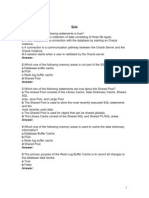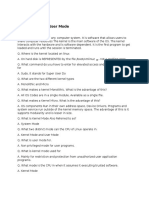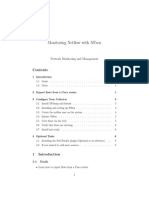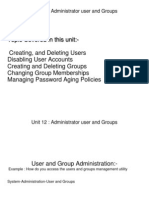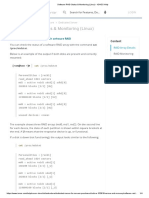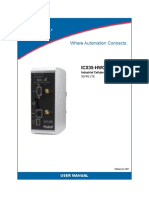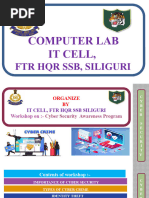100%(1)100% found this document useful (1 vote)
327 viewsLinux Test
CLI stands for Command Line Interface. Commands are case-sensitive. Options typically come before arguments in commands. The pwd command prints the current directory location. The cd command changes the current directory. Absolute paths begin with / while relative paths do not. The ~ character represents a user's home directory and .. represents the directory above the current one. The ls command without arguments lists the current directory contents. The chmod command changes file permissions. Administrative access is required to change file ownership.
Uploaded by
svmendezwCopyright
© © All Rights Reserved
Available Formats
Download as PDF, TXT or read online on Scribd
100%(1)100% found this document useful (1 vote)
327 viewsLinux Test
CLI stands for Command Line Interface. Commands are case-sensitive. Options typically come before arguments in commands. The pwd command prints the current directory location. The cd command changes the current directory. Absolute paths begin with / while relative paths do not. The ~ character represents a user's home directory and .. represents the directory above the current one. The ls command without arguments lists the current directory contents. The chmod command changes file permissions. Administrative access is required to change file ownership.
Uploaded by
svmendezwCopyright
© © All Rights Reserved
Available Formats
Download as PDF, TXT or read online on Scribd
You are on page 1/ 6
NDG Linux Unhatched Assessment Answers 100%
1. What does CLI stand for?
• Core Learning Interface
• Command Learning Interface
• Core Line Interface
• Command Line Interface
2. Commands are case-sensitive.
True or False?
• True
• False
3. When entering a command, do arguments or options
typically come first?
• Options
• Arguments
4. Which of the following is NOT a correct way to combine
options?
• -l -r
• -lr
• -r l
• -rl
5. Which command will print your current location in the
filesystem?
• pcl
• pwd
• pd
• cd
6. Which command will allow you to change your current
directory?
• ls
• cd
• ch
• chdir
7. Which of the following is NOT an example of an absolute
path?
• /
• /home/sysadmin
• Documents
8. Which of the following is NOT an example of a relative path?
• Documents
• /home
• Documents/Work
• home/sysadmin/Documents/School/Art
9. The ~ (tilde) character is used to represent:
• A user’s home directory
• Nothing, it doesn’t have a special meaning
• The current directory
• The directory above the current directory
10. The .. (double period) characters are used to represent:
• A user’s home directory
• The current directory
• Nothing, it doesn’t have a special
• The directory above the current directory
11. The . (period) character is used to represent:
• The directory above the current directory
• A user’s home directory
• The current directory
• Nothing, it doesn’t have a special meaning
12. The ls command without options or arguments…
• …lists the contents of the current directory.
• …prompts for a directory to list.
• …lists the contents of a user’s home.
• …generates an error as this command.
13. The first character in a long listing ls -l indicates:
• Hard Link Count
• File Size
• Permissions
• File Type
14. Which option to the ls will sort the output by file size?
• -z
• -r
• -S
• -s
15. Which of these commands will create a new shell
logged in as the root user?
• sudo
• su
16. Which of the following sets has the owner permissions
highlighted?
• rw-rw-r–
• rw-rw-r–
• rw-rw-r–
• rw-rw-r–
17. Which of the following sets has the group permissions
highlighted?
• rw-rw-r–
• rw-rw-r–
• rw-rw-r–
• rw-rw-r–
18. Which of the following sets has the other permissions
highlighted?
• rw-rw-r–
• rw-rw-r–
• rw-rw-r–
• rw-rw-r–
19. Which command will allow a user to change the
permissions of a file?
• perm
• chown
• chmod
• chperm
20. Which of the following permission sets indicates the
other owner has only the read permission?
• rw-r–rwx
• rwxrw-r-x
• r–r–r-x
• rw-rw-r–
21. Which of the following commands is used to change
the ownership of a file?
• chow
• chmod
• chown
• chperm
22. Changing the user owner of a file requires
administrative access.
True or False?
• True
• False
23. Which of the following commands can be used to
rename a file?
• name
• cp
• rn
• mv
24. The mv command requires at least two arguments.
True or False?
• True
• False
25. Which command can be used to copy a file?
• mv
• rm
• cy
• cp
26. The cp command requires at least two arguments.
True or False?
• True
• False
27. Which command is used to copy files at the bit level?
• cp
• dd
28. The rm command requires at least two arguments.
True or False?
• True
• False
29. Which option to the rm command will allow a user to
delete directories?
• -l
• -r
• -d
• -a
30. Which of the following commands is used to filter text?
• text
• grep
• dd
• regex
31. Which of the following commands will return only lines
that begin with test?
• grep ‘^test’ file.txt
• grep ‘$test’ file.txt
• grep ‘*test’ file.txt
• grep ‘[test]’ file.txt
32. Which of the following commands will return only lines
that end with test?
• grep ‘$test’ file.txt
• grep ‘test$’ file.txt
• grep ‘test^’ file.txt
• grep ‘^test’ file.txt
33. Which of the following lines would be NOT returned by
the grep ‘[^0-9]’ file.txt command?
• I am 37 years old.
• My favorite food is avocados.
• 3121991
• Hello my name is Joe.
34. Which of the following lines would be returned by the
grep ‘b[oe]t’ file.txt command?
• beet
• bet
• boet
• boot
35. Which of the following commands will NOT shutdown
the system immediately?
• shutdown
• shutdown now
• shutdown now ‘Goodbye World!’
• shutdown +0
36. Which of the following commands can be used to
display network configuration information?
• netconfig
• pwd
• ifconfig
• net
37. Which of the following commands will display every
process?
• ps –all
• ps -e
• ps
• ps -a
38. The ps command requires administrative access.
True or False?
• True
• False
39. Which of the following commands will update all
packages?
• apt-get upgrade
• apt-get update
• apt-get install
• apt-get search
40. Which of the following will delete all of a package’s
files?
• apt-get remove
• apt-get delete
• apt-get purge
• apt-get trash
41. Which of the following commands should be executed
before installing a package?
• apt-get upgrade
• apt-get update
• apt-get install
• apt-get search
42. Users can update their own passwords.
True or False?
• True
• False
43. The root user can change the password of any user.
True or False?
• True
• False
44. Which option can be used to view status information
about the current user’s password?
• -i
• -I
• -S
• -s
You might also like
- Realtimeinterviewquestions Com 2017 04 Linux Multiple Choice QuestionsNo ratings yetRealtimeinterviewquestions Com 2017 04 Linux Multiple Choice Questions12 pages
- NAIT Linux Exam Sample Questions Help For ICT480100% (5)NAIT Linux Exam Sample Questions Help For ICT4807 pages
- IPCop With DansGuardian Installation and ConfigurationNo ratings yetIPCop With DansGuardian Installation and Configuration6 pages
- 04 The IOS Operating System - Lab ExercisesNo ratings yet04 The IOS Operating System - Lab Exercises13 pages
- Linux Test Command Information and ExamplesNo ratings yetLinux Test Command Information and Examples4 pages
- Trend NXT Unix - Mock Test: Unix Questions and AnswersNo ratings yetTrend NXT Unix - Mock Test: Unix Questions and Answers10 pages
- Operating System (Lab Manual) : Department of Computer Science COMSATS University Islamabad, VehariNo ratings yetOperating System (Lab Manual) : Department of Computer Science COMSATS University Islamabad, Vehari10 pages
- 3.4.6 Lab - Configure VLANs and TrunkingNo ratings yet3.4.6 Lab - Configure VLANs and Trunking8 pages
- Linux InterviewQuestions For Level 2 by Ratnakar100% (1)Linux InterviewQuestions For Level 2 by Ratnakar286 pages
- Citrix Workspace App - Executive OverviewNo ratings yetCitrix Workspace App - Executive Overview44 pages
- Software RAID Status & Monitoring (Linux) - IONOS HelpNo ratings yetSoftware RAID Status & Monitoring (Linux) - IONOS Help4 pages
- COE301 Lab 13 Pipelined CPU Design With Data ForwardingNo ratings yetCOE301 Lab 13 Pipelined CPU Design With Data Forwarding8 pages
- 3 12th Business Maths Question Bank English MediumNo ratings yet3 12th Business Maths Question Bank English Medium109 pages
- PDF Reinventing Manufacturing and Business Processes Through Artificial Intelligence (Innovations in Big Data and Machine Learning) 1st Edition Geeta Rana Download100% (3)PDF Reinventing Manufacturing and Business Processes Through Artificial Intelligence (Innovations in Big Data and Machine Learning) 1st Edition Geeta Rana Download79 pages
- BER Bit Error Rate Tutorial and DefinitionNo ratings yetBER Bit Error Rate Tutorial and Definition5 pages
- Digital Libraries and Knowledge OrganizationNo ratings yetDigital Libraries and Knowledge Organization31 pages
- WT-90A V1.01 Elevator Voice Floor Announcer V1.01100% (2)WT-90A V1.01 Elevator Voice Floor Announcer V1.016 pages
- Chawla P. Blockchain, IoT, and AI Technologies For Supply Chain Management 2023No ratings yetChawla P. Blockchain, IoT, and AI Technologies For Supply Chain Management 2023295 pages
- Realtimeinterviewquestions Com 2017 04 Linux Multiple Choice QuestionsRealtimeinterviewquestions Com 2017 04 Linux Multiple Choice Questions
- IPCop With DansGuardian Installation and ConfigurationIPCop With DansGuardian Installation and Configuration
- Trend NXT Unix - Mock Test: Unix Questions and AnswersTrend NXT Unix - Mock Test: Unix Questions and Answers
- Operating System (Lab Manual) : Department of Computer Science COMSATS University Islamabad, VehariOperating System (Lab Manual) : Department of Computer Science COMSATS University Islamabad, Vehari
- Software RAID Status & Monitoring (Linux) - IONOS HelpSoftware RAID Status & Monitoring (Linux) - IONOS Help
- COE301 Lab 13 Pipelined CPU Design With Data ForwardingCOE301 Lab 13 Pipelined CPU Design With Data Forwarding
- 3 12th Business Maths Question Bank English Medium3 12th Business Maths Question Bank English Medium
- PDF Reinventing Manufacturing and Business Processes Through Artificial Intelligence (Innovations in Big Data and Machine Learning) 1st Edition Geeta Rana DownloadPDF Reinventing Manufacturing and Business Processes Through Artificial Intelligence (Innovations in Big Data and Machine Learning) 1st Edition Geeta Rana Download
- Chawla P. Blockchain, IoT, and AI Technologies For Supply Chain Management 2023Chawla P. Blockchain, IoT, and AI Technologies For Supply Chain Management 2023

















